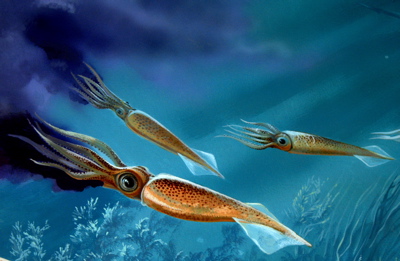
Midsummer Place from outside
Midsummer Place was opened in 2000 as an extension to the already popular Milton Keynes Shopping Centre, now re-branded thecentre:mk. Almost the entire floor of the Midsummer Place extension is laid with polished stone.
The majority of the stone in the centre is polished limestone, originating from the Jura mountains in Germany. This limestone was laid down during the Jurassic period of history, which is named after these mountains. Jura limestone formed under a warm calm ocean and small particles of calcium carbonate precipitated out of the sea water (in much the same way that the element of your kettle furs up over time). This calcium carbonate piled up over time and over millions of years it hardened and formed the hard limestone rock that you are walking on today. The colour of the limestone varies from light fawn to deep brown, depending on the concentration of calcium carbonate in the sample.
Jura limestone also features the fossilised remains of the creatures that lived in the sea at the time. The two main types of fossil that can be seen in the floor of the centre are ammonites and belemnites.

Ammonites
Ammonites were a prehistoric relative of the modern day squid. Ammonites were an incredibly successful species that survived for over 330 million years between the Devonian and Cretaceous periods. Ammonites are index fossils, in that it is often possible to link the stone in which they are found to a particular time period based on their genus. Ammonites usually show up in stone as spirals, that look a bit like modern day snail shells.

Belemnites
Belemnites also bear many resemblances to the modern day squid but are more closely related to the cuttlefish. Belemnites possessed an ink sac, which they used as a defense mechanism at times of distress and like ammonites existed from the Devonian to Cretaceous periods. The word Belemnite originates from the Greek belemnon meaning dart or arrow, because they usually show up as bullet-shaped darts in fossil remains.
In order to claim this earthcache please answer the following questions:
- Find a range of specimens each of ammonites and belemnites in the floor of the centre. Describe them in terms of size and shape.
- Examples of both light and dark limestone can be found throughout the centre. Which shade of limestone features more fossils? Why do you think this is?
Please do not share your answers in your log. Please email your answers to me using the link to my username above. Feel free to log the earthcache before you have received an email in response from me, however logs without accompanying emails to me with the answers will be deleted.
Please note that this earthcache relates to the floor in the Midsummer Place extension to the main shopping centre only. While the main shopping centre floor also features a range of polished stone from around the world, it features far fewer fossils than can be seen in Midsummer Place.
Permission has been given for this earthcache by intu Milton Keynes.